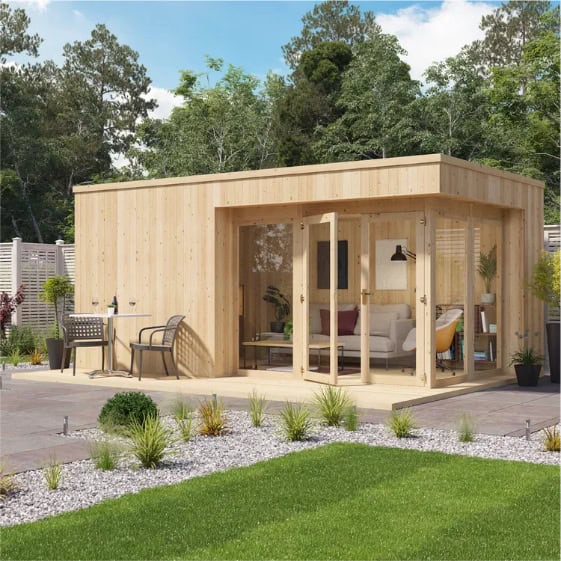Jump to:
The lifespan of garden rooms depends on things like the materials used and how well they’re looked after. If you’re thinking of getting one soon, it helps to know these considerations so you’ll have a better idea of what to expect before you commit.
This guide is a great starting point, covering material options and how each affects longevity, as well as a few tips to help the outdoor building last longer.
What Are My Material Options and Their Longevity?

The most common materials are wood, metal, and plastic.
Wood, especially when pressure-treated, can last a long time with minimal upkeep, as the treatment helps it resist rot and insect damage. As a natural material, it also resists moisture and decay. Untreated wood, in contrast, needs regular upkeep, like sealing and staining. But as long as you keep on top of it, a wooden garden room can last 20 to 30 years, or even longer! Our range of pressure treated log cabins proves this point.
Next, metal. Steel garden rooms often last for decades. However, they can be prone to rust if not properly treated—and if overlooked, this can reduce their expected longevity. A great alternative is galvanised or powder-coated steel. This finish makes the steel more resistant to corrosion while being low maintenance.
What Can I Do to Extend My Garden Room’s Lifespan?
Keep up with maintenance, even if your chosen material doesn’t require regular attention. This can be as simple as cleaning to prevent dirt and grim from building up. Or checking for damage, like loose panels, small cracks, or signs of rust, so that they won’t turn into bigger problems.
Clearing or draining gutters is also a good habit to add to your routine. This saves you the trouble of dealing with pooled water around your garden room and damp issues.
Proper ventilation is another way to ensure your investment stays functional for many years. Good airflow is what keeps moisture, mould, and condensation at bay. Open the windows or doors for a couple of hours a day to let some fresh air in. And to keep uninvited insects or bugs out while doing so, just attach some screens.
Give our guide a read to learn more: Log Cabin Maintenance Checklist – Painting, Repairs and Checks
Signs Your Garden Room Needs Attention
Cracks or splits in the wood or metal indicate that something might be off and needs fixing. Mould or mildew growth is another thing to watch for, as it could mean there’s too much moisture. And if you spot water stains on the walls or ceiling, it might be a sign of leaks that need sorting.
Keep an eye on any doors or windows that are tricky to open or close. It could mean there’s a problem with the frame or foundation. Watch out for pests like termites or carpenter ants—these little creatures can chew through the wood.
Stay on top of these things and sort them out early so you don’t end up with bigger concerns later on.
Round-up
The materials used in building your garden room really affect how long it lasts. Pressure-treated wood will last longer than untreated wood, no question. For metal, go for galvanised or powder-coated steel—it’s more weather-resistant and needs less upkeep. And if you’re after something lightweight, UV-resistant polypropylene is a great shout for a plastic garden room.
With these material tips, you can get a garden room that will last 20 years or more!
Ready to choose a building? Read our garden rooms buying guide to get started.










